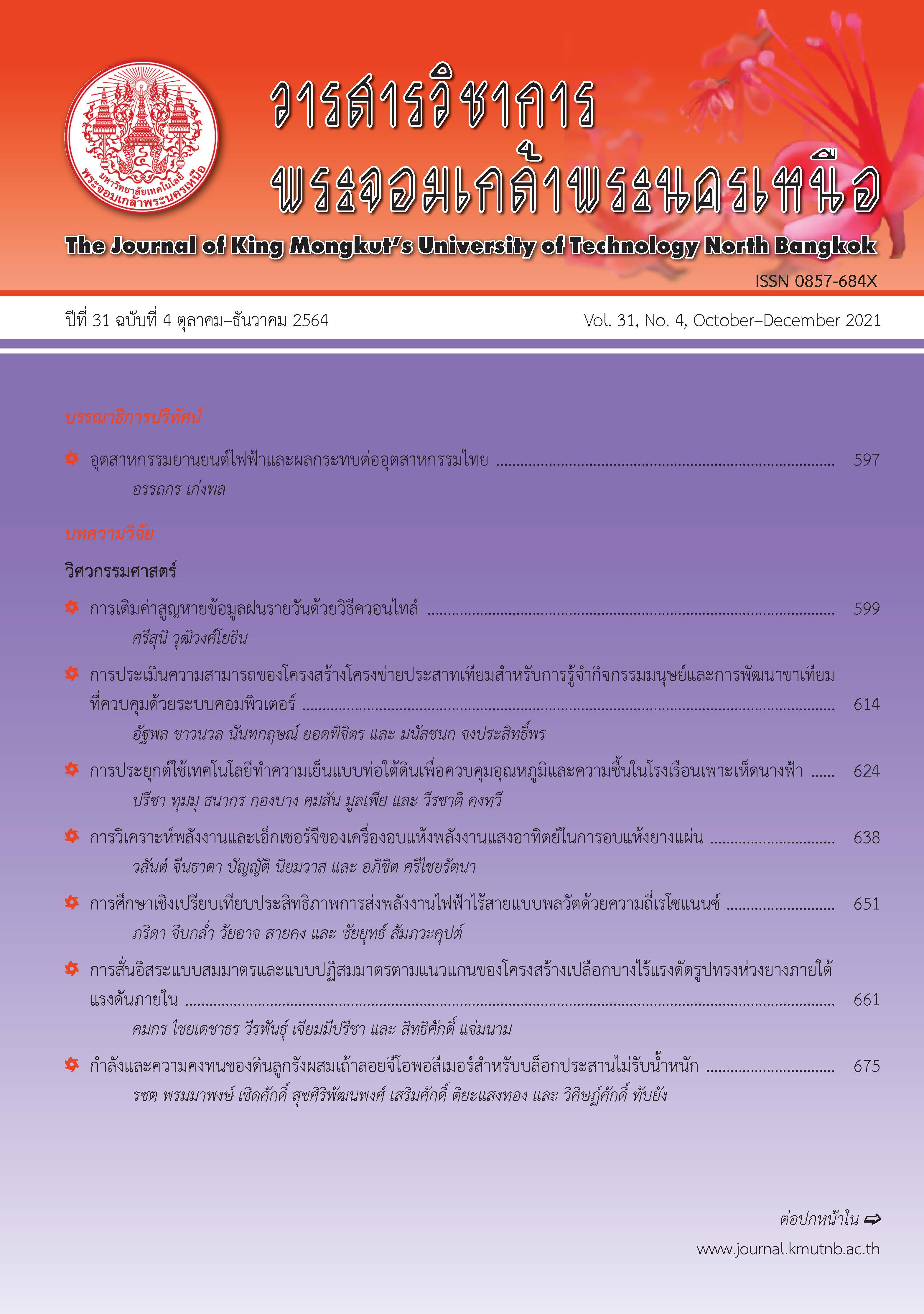การวิเคราะห์พลังงานและเอ็กเซอร์จีของเครื่องอบแห้งพลังงานแสงอาทิตย์ในการอบแห้งยางแผ่น
Main Article Content
บทคัดย่อ
งานวิจัยนี้เป็นการทดลองอบแห้งยางแผ่นด้วยเครื่องอบแห้งพลังงานแสงอาทิตย์และทำการวิเคราะห์พลังงานและเอ็กเซอร์จีของกระบวนการอบแห้ง ใช้เวลาในการอบแห้ง 5 วัน โดยวันที่ 1 ควบคุมอัตราการไหลอากาศไว้ที่ 0.248 กิโลกรัม/วินาที วันที่ 2-5 ควบคุมอัตราการไหลอากาศไว้ที่ 0.020 กิโลกรัม/วินาที การอบแห้งวันที่ 1 มีอุณหภูมิห้องอบแห้ง 32-40 ?ซ ความชื้นสัมพัทธ์ห้องอบแห้ง 44-72% และรังสีดวงอาทิตย์ 428-1089 วัตต์/เมตร2 วันที่ 2-5 อุณหภูมิห้องอบแห้ง 34-54 ?ซ ความชื้นสัมพัทธ์ห้องอบแห้ง 27-72% และรังสีดวงอาทิตย์ 136-1042 วัตต์/เมตร2 จากผลการทดลองพบว่าที่อัตราการไหลอากาศสูงอุณหภูมิในห้องอบแห้งจะต่ำลงในขณะที่ประสิทธิภาพแผงรับรังสีดวงอาทิตย์สูงขึ้น ในทางกลับกันเมื่ออัตราการไหลของอากาศต่ำลงอุณหภูมิในห้องอบแห้งจะสูงขึ้นในขณะที่ประสิทธิภาพแผงรับรังสีดวงอาทิตย์ต่ำลง เครื่องอบแห้งมีค่าความสิ้นเปลืองพลังงานจำเพาะ 31369.27 วัตต์-ชั่วโมง/กิโลกรัม ความสิ้นเปลืองพลังงานไฟฟ้าจำเพาะ 465.77 วัตต์-ชั่วโมง/กิโลกรัม และประสิทธิภาพทางความร้อน 2.11% เอ็กเซอร์จีของการอบแห้งวันที่ 1 เอ็กเซอร์จีไหลเข้า เอ็กเซอร์จีไหลออก และเอ็กเซอร์จีสูญเสียมีค่า 40-246, 5-166 และ 18-81 วัตต์ ตามลำดับ มีค่าสูงกว่าวันที่ 2-5 ที่มีค่า 4-91, 2-77 และ 1-43 วัตต์ ตามลำดับ แต่การอบแห้งวันที่ 1 มีประสิทธิภาพเอ็กเซอร์จี 12-79% ต่ำกว่าวันที่ 2-5 มีประสิทธิภาพเอ็กเซอร์จี 42-94% เนื่องจากที่อัตราการไหลอากาศสูงเอ็กเซอร์จีสูญเสียก็จะสูงตามไปด้วยทำให้ประสิทธิภาพเอ็กเซอร์จีต่ำลง
Article Details
บทความที่ลงตีพิมพ์เป็นข้อคิดเห็นของผู้เขียนเท่านั้น
ผู้เขียนจะต้องเป็นผู้รับผิดชอบต่อผลทางกฎหมายใดๆ ที่อาจเกิดขึ้นจากบทความนั้น
เอกสารอ้างอิง
[2] A. Djebli, S. Hanini, O. Badaoui, B. Haddad, and A. Benhamou, “Modeling and comparative analysis of solar drying behavior of potatoes,” Renewable Energy, vol. 145, pp. 1494–1506, 2020.
[3] R. Dejchanchaiwong, A. Arkasuwan, A. Kumar, and P. Tekasakul, “Mathematical modeling and performance investigation of mixed-mode and indirect solar dryers for natural rubber sheet drying,” Energy for Sustainable Development, vol. 34, pp. 44–53, 2016.
[4] W. Jeentada and P. Phetsongkram, “Geometrical effects of solar greenhouse dryer on rubber sheet drying,” The Journal of KMUTNB, vol. 27, no. 1, pp. 89–99, 2017 (in Thai).
[5] W. Jeentada, J. Jareanjit, and P. Tippracha, “Drying experiment of rubber sheet using solar dryer with solar collector installed on top wall of the dryer,” The Journal of KMUTNB, vol. 29, no. 1, pp. 23–33, 2019 (in Thai).
[6] M. C. Ndukwu, L. Bennamoun, F. I. Abam, A. B. Eke, and D. Ukoha, “Energy and exergy analysis of a solar dryer integrated with sodium sulfate decahydrate and sodium chloride as thermal storage medium,” Renewable Energy, vol. 113, pp. 1182–1192, 2017.
[7] A. Fudholi, K. Sopian, M. A. Alghoul, M. H. Ruslan, and M. Y. Othman, “Performances and improvement potential of solar drying system for palm oil fronds,” Renewable Energy, vol. 78, pp. 561–565, 2015.
[8] W. Nilnont and S Phitakwinai, “Energy and exergy potential assessment of solar tunnel dryer,” Engineering Journal of Research and Development, vol. 30, no. 3, pp. 91–107, 2019 (in Thai).
[9] D. K. Rabha, P. Muthukumar, and C. Somayaji, “Energy and exergy analyses of the solar drying processes of ghost chilli pepper and ginger,” Renewable Energy, vol. 105, pp. 764–773, 2017.
[10] S. Vijayan, T. V. Arjunan, and A. Kumar, “Exergo-environmental analysis of an indirect forced convection solar dryer for drying bitter gourd slices,” Renewable Energy, vol. 146, pp. 2210–2223, 2020.
[11] T. Naemsai, J. Jareanjit, and W. Jeentada, “Effect of free convection on rubber sheets drying process using energy and exergy analyses,” RMUTSB Academic Journal, vol. 3, no.1, pp. 66–78, 2015 (in Thai).
[12] K. Chapchaimoh, N. Poomsa-ad, L. Wiset, and J. Morris, “Thermal characteristics of heat pump dryer for ginger drying,” Applied Thermal Engineering, vol. 95, pp. 491–498, 2016.
[13] B. Tanwanichkul, S. Thepa, and W. Rordprapat, “Thermal modeling of the forced convection sandwich greenhouse drying system for rubber sheets,” Energy Conversion and Management, vol. 74, pp. 511–523, 2013.
[14] X. Wu, M. Zhang, and Z. Li, “Inflence of infrared drying on the drying kinetics, bioactive compounds and flvor of cordyceps militaris,” LWT - Food Science and Technology, vol. 111, pp. 790–798, 2019.
[15] B. M. A. Amer, K. Gottschalk, and M. A. Hossain, “Integrated hybrid solar drying system and its drying kinetics of chamomile,” Renewable Energy, vol. 121, pp. 539–5470, 2018.
[16] A. E. khadraoui, I. Hamdi, S. Kooli, and A. Guizani, “Drying of red pepper slices in a solar greenhouse dryer and under open sun: Experimental and mathematical investigations,” Innovative Food Science and Emerging Technologies, vol. 52, pp. 262–270, 2019.
[17] Y. Qiu, M. Li, R. H. E. Hassanien, Y. Wang, X. Luo, and Q. Yu, “Performance and operation mode analysis of a heat recovery and thermal storage solar-assisted heat pump drying system,” Solar Energy, vol. 137, pp. 225–235, 2016.
[18] P. Wang, D. Mohammed, P. Zhou, Z. Lou, P. Qian, and Q, Zhou, “Roof solar drying processes for sewage sludge within sandwich h-like chamber bed,” Renewable Energy, vol. 136, pp. 1071–1081, 2019.
[19] L. V. E. Cesar, C. M. A. Lilia, G. V. Octavio, P. F. Isaac, and B. O. Rogelio, “Thermal performance of a passive, mixed-type solar dryer for tomato slices (Solanum lycopersicum),” Renewable Energy, vol. 147, pp. 845–855, 2020.
[20] A. B. Lingayat, V. P. Chandramohan, V. R. K. Raju, and V. Meda, “A review on indirect type solar dryers for agricultural crops-Dryer setup, its performance, energy storage and important highlights,” Applied Energy, vol. 258, pp. 114005, 2020.
[21] M. M. Morad, M. A. El-Shazly, K. I. Wasfy, and H. A. M. El-Maghawry, “Thermal analysis and performance evaluation of a solar tunnel greenhouse dryer for drying peppermint plants,” Renewable Energy, vol. 101, pp. 992–1004, 2017.
[22] W. Wang, M. Li, R. H. E. Hassanien, Y. Wang, and L. Yang, “Thermal performance of indirect forced convection solar dryer and kinetics analysis of mango,” Applied Thermal Engineering, vol. 134, pp. 310–321, 2018.
[23] A. Ziaforoughi, and J. A. Esfahani, “A salient reduction of energy consumption and drying time in a novel PV-solar collector-assisted intermittent infrared dryer,” Solar Energy, vol. 136, pp. 428–436, 2016.
[24] J. P. Ekka, K. Bala, P. Muthukumar, and D. K. Kanaujiya, “Performance analysis of a forced convection mixed mode horizontal solar cabinet dryer for drying of black ginger (Kaempferia parviflora) using two successive air mass flow rates,” Renewable Energy, vol. 152, pp. 55–66, 2020.
[25] M. S. H. Sarker, M. N. Ibrahim, N. A. Aziz, and M. S. Punan, “Energy and exergy analysis of industrial fluidized bed drying of paddy,” Energy, vol. 84, pp. 131–138, 2015.
[26] O. Prakash, A. Kumar, and V. Laguri, “Performance of modified greenhouse dryer with thermal energy storage,” Energy Reports, vol. 2, pp. 155–162, 2016.
[27] F. Afzali, H. Darvishi, and N. B. Khazaei, “Optimizing exergetic performance of a continuous conveyor infrared-hot air dryer with air recycling system,” Applied Thermal Engineering, vol. 154, pp. 358–367, 2019.

